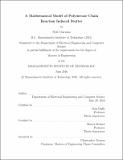A mathematical model of polymerase chain reaction induced stutter
Author(s)
Gurram, Neil (Neil K.)
DownloadFull printable version (2.973Mb)
Other Contributors
Massachusetts Institute of Technology. Department of Electrical Engineering and Computer Science.
Advisor
Ken Duffy and Muriel Medard.
Terms of use
Metadata
Show full item recordAbstract
This is a thesis on understanding stutter present in capillary electropherogram readouts as this methodology forms the basis of current DNA fingerprinting. The readouts come from taking samples of various initial template masses of DNA from different individuals, applying polymerase chain reaction (PCR) to the samples, and then running the amplified copies through capillary electrophoresis to produce a readout of peak heights corresponding to alleles on various loci. The alleles correspond to the number of repeats of microsatellites that are usually two to six base pairs in length called short tandem repeats (STRs); the number of repeats of various STRs defines a person's DNA fingerprint. This process introduces artifacts in measurement. Of particular interest in this thesis is stutter, the phenomenon where amplicons with fewer or greater number of STR repeats than the true allele count are generated as an artifact of the PCR. It is of interest to understand the source and nature for this stutter distribution for small starting masses, as it has ramifications on the ability to accurately determine a match between a DNA sample and a crime scene sample. Understanding the stutter distribution in this thesis is achieved through data analysis, probabilistic modeling, and statistics. We find that a mathematical model that combines stochastic effects from PCR with fluorescent noise explains the most significant features of the observed phenomena.
Description
Thesis: M. Eng., Massachusetts Institute of Technology, Department of Electrical Engineering and Computer Science, 2016. This electronic version was submitted by the student author. The certified thesis is available in the Institute Archives and Special Collections. Cataloged from student-submitted PDF version of thesis. Includes bibliographical references (page 48).
Date issued
2016Department
Massachusetts Institute of Technology. Department of Electrical Engineering and Computer SciencePublisher
Massachusetts Institute of Technology
Keywords
Electrical Engineering and Computer Science.